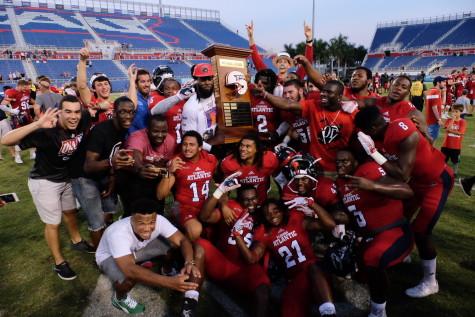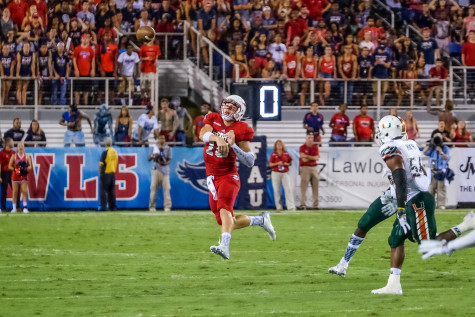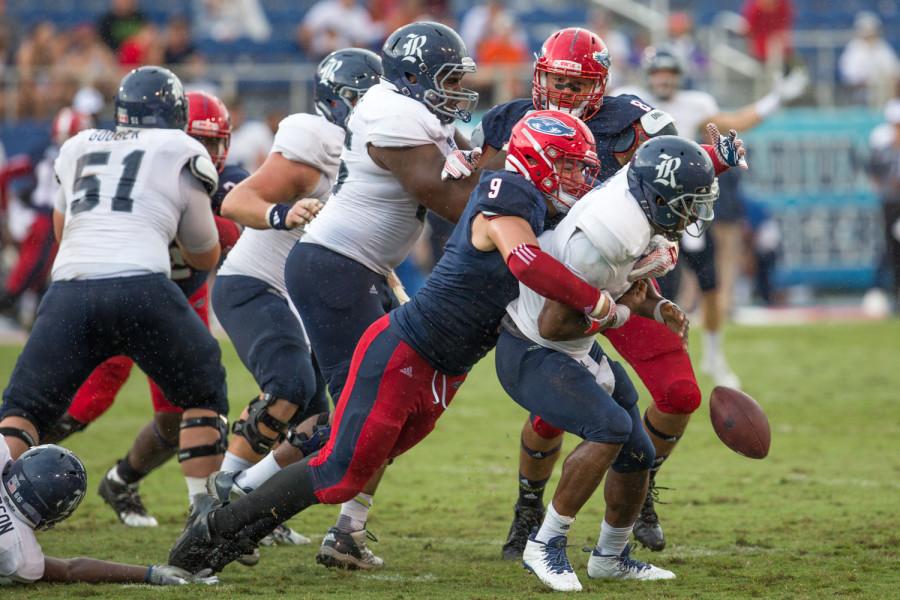Opinion: Light at the end of the tunnel
Coming off another losing season, capitalizing on development of young talent will decide future for Charlie Partridge
Junior defensive end Trey Hendrickson (9) sacks Rice quarterback Driphus Jackson (6) during FAU’s 27-26 loss on Oct. 10. Hendrickson ended the year as FAU’s all time sack leader with 20. Brandon Harrington | Photo Editor
December 5, 2015
It’s hard to pick a single word to describe football’s season. Disappointing? To most, yes. Promising? At times. Stagnant? Mostly in the second half of games, but not in full.
Second year head coach Charlie Partridge surely wouldn’t be able to tell you the full story as to what happened, but he does have one message you might want to follow.
“We’re building a program here.”
In five simple words after his team’s 20-14 overtime loss to the then No. 8 ranked Florida Gators on Nov. 21, Partridge laid out his long-term vision for the future of the Owls.
He knows that his team has gone 6-18 since he took the helm in 2014, and that they’ve had just one road win in the past two years. He knows they’ve lost five games this season by 10 points or fewer, the same total as last year.
He could easily rattle off numbers, figures, points, data and records that could tell you that this was another lost season in Florida Atlantic football history, and that his seat during his third year in Boca Raton is hotter than the temperature of a noon home game in September.
But Partridge’s team might be closer to competing than most fans and casual observers are giving them credit for. While a year is defined by the win-loss column, the actions you take off the field work to define forward or backward progress for the future.
Undoubtedly, Partridge shone bright as a recruiter. For his first signing class in 2015, he was ranked the second best in Conference USA, behind defending conference champion Marshall, and 75th overall by 247sports.com.
Raised in Plantation, Florida, his ties to local high school coaches in South Florida have helped him compete against the likes of local powers Miami, Florida and Florida State in finding talent to fill his roster.
Some freshmen from that class have already made an impact, especially on defense. Linebacker Azeez Al-Shaair has been stellar at times, while safety Jalen Young and defensive back Ocie Rose have quietly become the backbone of the Owls’ secondary.

Young and Rose each had three interceptions during the year, helping the Owls set a new program record for interception return yards in a season with 347, good for sixth among all FBS teams. Al-Shaair led the team with 94 tackles, playing in every game this season.
While losing graduating defensive back Cre’von LeBlanc, who contributed three interceptions in his final year, the young unit has a chance to flourish and build up its reputation for talent as it has in the past.
The defensive line presence of seniors Trevon Coley and Brandin Bryant may be the hardest thing for the Owls to replace, but defensive end Trey Hendrickson will make the transition easier. The junior finished second in the FBS with 13.5 sacks, a new single-season sack record for the Owls.
Hendrickson’s 20 career sacks are a program record, giving opponents another reason to remember his name for next year. Returning with him on the line that registered the most sacks in C-USA (35) will be redshirt sophomore Nick Internicola, redshirt freshman Hunter Snider and redshirt senior Shalom Ogbonda.
As the defense improved toward the end of the season, offensive inconsistency was a constant for the Owls. Redshirt freshman Jason Driskel had to step in as starting quarterback during the Owls’ tilt against Miami on Sept. 11, replacing redshirt senior Jaquez Johnson during the second half.
Johnson’s final season was marred by injury, as it limited his playmaking ability with his feet and forced him to be less mobile.
He finished with career-low numbers — 1,549 passing yards, nine passing touchdowns and seven interceptions while rushing for 289 yards and two touchdowns.

With Johnson out for two of the first six games with an ankle injury, Driskel’s performances were unpredictable. At times he made freshman mistakes, missing receivers with high, errant throws and turning the ball over a total of five times.
Driskel did show poise in other moments. He threw for three touchdowns and 965 yards of passing. His success saw him playing in more drives as the season progressed, including much of the second half of the team’s final game versus Old Dominion.
Next year’s quarterback battle will pit Driskel against Dwyer High product Daniel Parr, another pickup from the signing class of 2015. Driskel looks to have an edge in the experience category, but Parr showed his potential in practice and during last year’s spring game.
As for receiving options, the unit takes a huge hit with the loss of Jenson Stoshak. The senior had 820 receiving yards on 59 receptions to lead the team as their primary pass catching option.
Sophomores Henry Bussey, Kalib Woods and Nate Terry will make up the pass options for next season and will have their work cut out for them in filling the production gaps.
The strength of FAU’s offense for the foreseeable future must come from its running backs. The Owls return four — you read that right — running backs who received substantial playing time during the year.
Junior Jay Warren, sophomore Greg Howell, and freshmen Trey Rodriguez and Marcus Clark all ran for at least 100 yards and a score each.
While Howell and Warren combined for 1,047 yards and six scores, their inconsistency and turnovers early in the season led to the breakout chances for both freshman backs.
Rodriguez scored a touchdown in five of the six games he played before a shoulder injury sidelined him for the final two games of the year, while Clark found a role as a receiving weapon out of the backfield.
Partridge will have to figure out how to get all of his running backs involved. It may benefit the Owls to change to a two-back set up.
I predicted the Owls to go 8-4 before the start of the season. What I saw was a young team with more potential than last year.
What transpired looked more like the season before: more second half disappearances, more unfinished drives and more missed opportunities all around. The Owls had six potential games that could have went either way for them, including two overtime losses.
What that 3-9 record looks like right now is a missed chance at the Owls’ first bowl eligibility in two years. But through all the losses, there is a major chance for a breakthrough.
If Partridge has shown anything over these past two seasons, it’s that he can breathe potential into the program and bring in talented prospects. Although, talent can only get you so far on paper, which means the Owls may look in another direction next season if there’s no change.
Ryan Lynch is the sports editor of the University Press. For tips regarding this or other articles, he can be contacted at ryanmlynch77@gmail.com or on Twitter.







